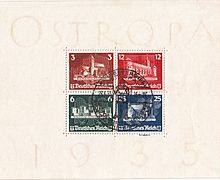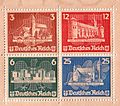Ostropa block
The Ostropa block, the third block issue of the German Reich, is one of the philatelic rarities of the stamp issue period from 1872 to 1945. It was published on the occasion of the Königsberg stamp exhibition OSTROPA 1935.
backgrounds
On the occasion of the OSTROPA (International Eastern European Postage Stamp Exhibition) in Koenigsberg from June 23rd to July 3rd, 1935, the Deutsche Reichspost issued this block, which was already a rarity on the day of issue , as it was only available in very limited numbers on purchase tickets.
The design itself is based on Professor Dr. Franz Marten back, the execution took place in steel engraving intaglio printing process on coated security paper .
The unit of four in denominations of 3, 6, 12 and 25 Reichspfennig (which corresponded to the four most common postage levels at the time for domestic printed matter, postcard, letter and international letter) shows Allenstein Castle in the brand image and the map of East Prussia in the background (3 pfennigs, orange-brown ), the Tannenberg monument in front of the stylized imperial eagle (6 pfennigs, dark blue-green), the Königsberg Castle in front of the East Prussian shield (12 pfennigs, red) and Heilsberg Castle with an oak leaf backing (25 pfennigs, dark blue). The order of the value steps clockwise from the top right is 12 - 25 - 6 - 3.
When choosing the colors, the Reichspost based itself on the recommendations of the Universal Postal Union , according to which one could recognize the purpose of the value level from the color.
The block (dimensions 148 x 104 mm) has the inscription OSTROPA above the stamps as a watermark on the edge of the block and the year 1935 below the unit of four (the so-called centerpiece). The four stamps bear the German Order Cross as a watermark , which was perceived as an homage to the seat of the German Order in Königsberg even then .
The original edition was 162,700 pieces, of which more than half were cut up or used up in heart pieces. A not inconsiderable portion was officially destroyed after the expiry date on December 31, 1935.
Authorization cards
The pad was sold at the post office price of 1.70 Reichsmarks at the collector's counter only in connection with the authorization card or the admission ticket. Nevertheless, the block or the centerpiece or the individual stamps had full postage force .
Vignettes
As part of the exhibition, four different closure vignettes with motifs from the Königsberg area were also available. In combination with the Ostropa block on letter, these represent a special philatelic value.
Gumming
The attraction of this issue is caused by an error in the manufacture of the block. Since the Reichspost wanted to reduce the cost of the expensive gum arabic , a series of tests was started to produce a substitute material from existing raw materials. The glue made from animal bones as the base material for the gumming had a high sulfuric acid content due to the manufacturing process . Inadvertently, the acid content was not neutralized. Over the years, the low pH value of the gumming has attacked the security paper very severely, which is why there are hardly any undamaged pieces. This was already known to collectors in the year of issue, which is why it was recommended to remove the gum immediately with a water bath at the time of purchase. The pieces shown each have a certain degree of damage. The most common are the so-called watermark breaks, in which the already thinner areas have broken out over time. Rather rare and therefore more interesting for the special collector are holes in the stamp image or in the block edge. Just a few years after spending, numerous blocks could only be saved from complete disintegration through often bumbling repairs (see images).
Despite the knowledge of the rubber damage, the Reichspost used the gum remaining from the production of the OSTROPA security paper a few months later for the Zeppelin airmail stamps " LZ 129 to North America".
Degree of conservation
Items that are actually used by post are very rare, the Ostropa block hardly ever appears with local postmarks, so it is very susceptible to falsification.
The special postmarks of the Königsberg-OSTROPA special post office (with the dates June 23, 1935 up to and including July 3, 1935), as well as OSTROPA 1935 / Cranz-ROSSITTEN SCHIFFSPOST and OSTROPA 1935 / SCHIFFSPOST / MOOSBRUCH can be found relatively often in the case of cancellations . The special postmarks are relatively little prone to forgery, other colored cancellations are, according to experts, not of official origin and are therefore generally to be regarded as value-reducing courtesy cancellation (i.e. cancellation at the counter without actually being used as a postage stamp).
Ostropa blocks in mint condition are extremely rare. Usually the Ostropa block is degummed (*); it is then - regardless of this actual defect - still considered to be of full value.
Varieties
In contrast to many editions of the German Reich, despite intensive research, no color variations, significant plate errors, watermark errors or other variations are known of the Ostropa block. The printing process (manual hand printing press) in four work steps, i. H. Each brand image itself was printed separately on the pre-perforated and gummed paper, known deviations in the distance between the brands are due to the manufacturing process (up to one millimeter) and therefore do not deserve any premium in terms of value. The philatelist calls this a so-called "register shift". However, there is a test print with missing perforation, which experts do not rate below 20,000 euros.
Value and Notes
Due to the rarity of a flawless block with original gum, it is not possible to state the value, a stamped copy is valued at 900 euros, an unused 1,000 euros, and a genuine letter of need not less than 1,100 euros.
For stamp collectors z. Some very high quality reprints; this allows gaps in postage stamp albums to be concealed, at least visually.
Individual evidence
- ↑ Wolfgang Greiner (2011): Why is the 10 Pfg. Heuss green?
- ^ Michel-Spezial Katalog Deutschland 2007 (paperback), page 408, publisher: Schwaneberger Verlag GmbH (2007), ISBN 3-87858-137-8

























